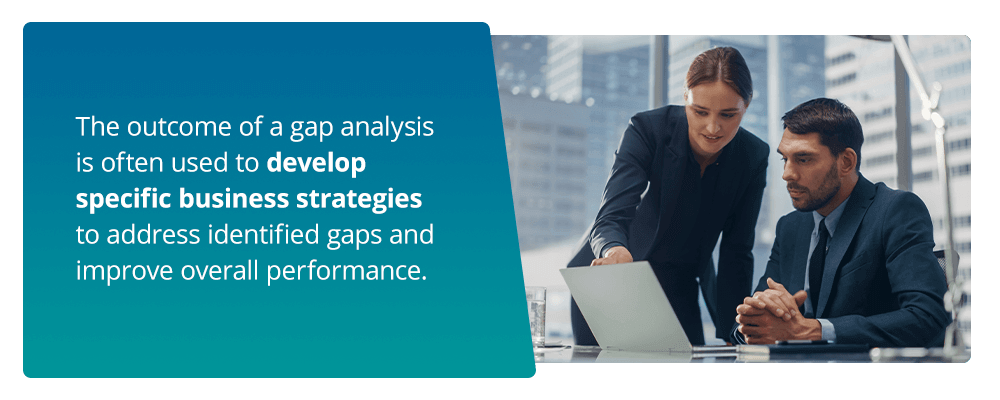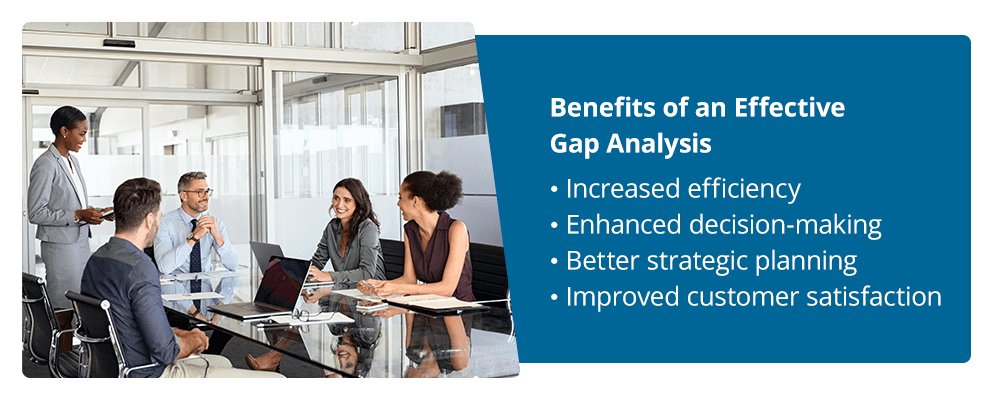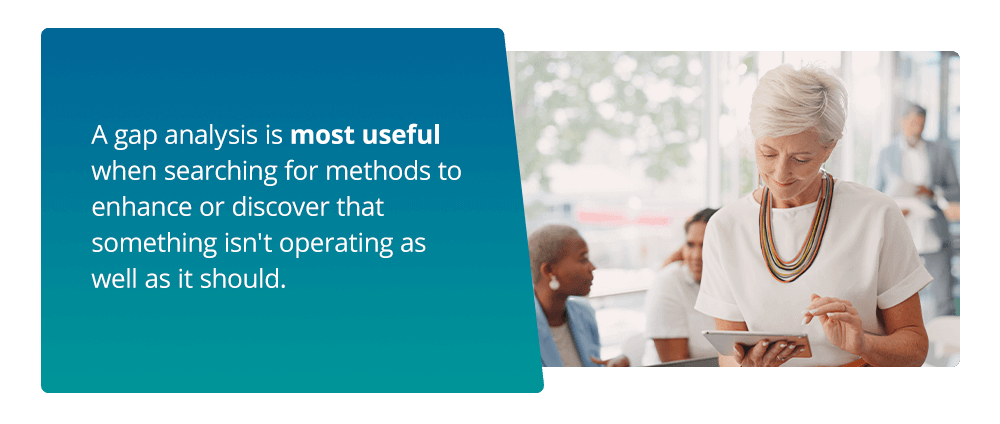Companies must recognize the importance of strategic plans and follow through to implement them. Companies can use gap analysis to develop strategic plans to identify any gaps or inadequacies they may have in their performance. As a result, they can build solutions to overcome various challenges and enhance business operations.
Though it may seem challenging, you can complete a gap analysis in four simple steps.
In This Article
- What Is a Gap Analysis?
- The Difference Between a Gap Analysis and a SWOT Analysis
- When to Use a Gap Analysis
- Benefits of an Effective Gap Analysis
- The 4 Steps of a Gap Analysis
- Gap Analysis Examples
- Ready to Complete a Gap Analysis? Let’s Actually Do This.
What Is a Gap Analysis?
A gap analysis is a tool that identifies the difference between an organization’s current and desired state. The difference between those two states is known as “the gap.” The outcome of a gap analysis is often used to develop specific business strategies to address identified gaps and improve overall performance.

Depending on the organization’s needs and goals, it can conduct different types of gap analysis:
- Performance gap: Also known as the strategy gap, the performance gap is the difference between expected and actual performance.
- Market gap: Also called the product gap, the market gap is the difference between the budgeted and actual sales.
- Profit gap: This is the difference between the targeted and actual profit.
- Manpower gap: This is the difference between the required number or performance of the personnel and the actual number or performance.
The Difference Between a Gap Analysis and a SWOT Analysis
Both gap and strength, weakness, opportunity and threat (SWOT) analysis are two commonly used business tools for evaluating the performance and potential of an organization. While both tools have similarities, they differ in their approach and objectives.
A gap analysis assesses the difference between the current state of a business and its desired state, providing a roadmap to achieve those intended circumstances.
In comparison, a SWOT analysis assesses an organization’s strengths, weaknesses, opportunities and threats. It identifies internal and external factors that can impact an organization and helps identify areas for improvement and growth.
Unlike a gap analysis, which focuses solely on the organization and can be seen as a quantitative tool, a SWOT analysis considers the organization’s external environment, including market trends, competition and regulatory requirements, which can be seen as a qualitative tool.
FREE RESOURCE
Leading from the Center
Download this guide to understand how to optimize power and influence to accomplish your most important initiatives.

When to Use a Gap Analysis
An organization can use a gap analysis whenever an improvement is desired. The more data points you have, the easier it is to establish a gap analysis. However, even new organizations with no data can start from scratch.
Here are some scenarios where one can utilize a gap analysis:
- Improve processes: A gap analysis can be used to assess the effectiveness of current processes and identify areas for improvement. This helps organizations reduce costs and improve efficiency.
- Manage change: When organizations undergo significant changes, a gap analysis can help them assess the impact of those changes and identify potential risks.
- Evaluate profits: A gap analysis can help identify why the business could not meet a projected profit. It can aid in identifying issues such as strong or unexpected competition and inadequate resource allocation, among others.
- Understand KPIs: A gap analysis may help you better understand key performance indicators, including client acquisition and sales objectives.
Benefits of an Effective Gap Analysis

A gap analysis is an excellent technique that can benefit organizations of all sizes and industries when executed effectively. Here are some of the most significant benefits of an effective gap analysis:
- Increased efficiency: By identifying areas for improvement and streamlining processes, a gap analysis helps organizations become more efficient. This may lead to reduced costs and increased productivity.
- Enhanced decision-making: A gap analysis provides valuable data that can inform decision-making at all levels of an organization. By having a clear understanding of their strengths, weaknesses and opportunities, organizations can make more informed decisions.
- Better strategic planning: A gap analysis provides valuable insights into an organization’s resources, processes and goals. This information can inform a more effective strategic plan and help achieve better results.
- Improved customer satisfaction: By identifying and addressing areas of weakness, a gap analysis can help organizations improve their customer satisfaction, which may lead to increased customer loyalty and higher profits.
The 4 Steps of a Gap Analysis
By following these four gap analysis steps and setting up a gap analysis diagram, you will know how to do a gap analysis, identify areas for improvement, determine the causes of the gaps and develop a plan of action to close them and achieve their desired state.
1. Assess Your Current State
The first step in conducting a gap analysis is to assess the organization’s current state. This involves evaluating the organization’s current resources, processes and outcomes and comparing them with the desired state.
Do you have a strategic plan or Balanced Scorecard? How about the KPIs you’re tracking throughout the year? What other information can you gather about the state of affairs?
2. Establish SMART Goals
Establish specific, measurable, achievable, relevant and time-bound (SMART) goals of what your desired states look like. By following the SMART framework, your organization can set goals that are much more straightforward to achieve. A gap analysis provides an opportunity to ensure you’re on track with achieving the organization’s stated goals.

It allows a better understanding of key objectives and what’s working and not working. Most organizations have a set of recurring goals and objectives. But only some continue to reevaluate the goals throughout the year. It’s important to review your goals and recalibrate them as necessary.
3. Identify Gaps
Now that you have a firm grasp on where you are and where you’d like to be, it’s time to start bridging the gap. At this step, it’s vital to be transparent and ask critical questions of your organization.
The answers to these questions will help identify the gaps. Once you’ve identified the gaps, you can determine their causes. This involves evaluating the internal and external factors contributing to the gaps, such as market trends and competition.
4. Devise a Plan to Close the Gaps
Now, it’s time to devise a plan to close these gaps. Build a roadmap with waypoints along the way — monthly or quarterly — so you can ensure you’re still heading in the right direction. This involves determining the actionable steps needed to address the causes of the gaps, and the resources, processes and outcomes required to achieve the desired state.
Gap Analysis Examples
A gap analysis is most useful when searching for methods to enhance or discover that something isn’t operating as well as it should. Here are some gap analysis examples:
- Product launch: Businesses can conduct a gap analysis before releasing a new product to the market. This will assist them in identifying areas for progress and where they’re presently thriving.
- Project management: Use gap analysis throughout the project planning or review stages to identify sections falling behind the rest of the project. Then, you may request and allocate resources to that job if needed.
- Competitive research: Competitive analyses are helpful tools for increasing consumer satisfaction. A gap analysis, in which you look at the market gap for your industry and devise methods for your firm to fill it, is one technique to do the essential competition research.
- Individual assessment: As a team leader, you’re frequently concerned with the bigger picture. As a result, information might fall through the cracks and cause delays or problems later on. A gap analysis helps you detect when you may have missed something and it can spot them before they become a significant issue.

Ready to Complete a Gap Analysis? Let’s Actually Do This.
Do you need help completing your gap analysis? Transform your strategic planning process with strategic planning software designed specifically for your organization, regardless of the planning style, size or industry.
Organizations must constantly evolve and adjust to meet market demands to achieve success. Business transformation and change management software will assist in planning your next steps. With AchieveIt, you’ll get the real-time information you need to better anticipate and alter your plans to guarantee success thanks to data reporting, visualization, analysis and alerts.
Request a demo to understand why major businesses rely on AchieveIt to carry out their strategies.
Ready to improve your plan execution?
Organizations of all types leverage AchieveIt to manage, execute, and connect their most important initiatives. Replace manual processes & siloed systems with interconnected plans in a single, automated platform.



